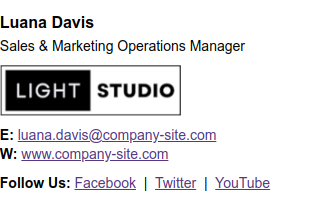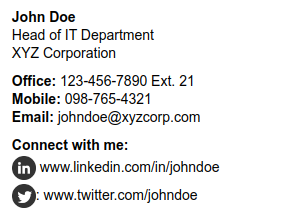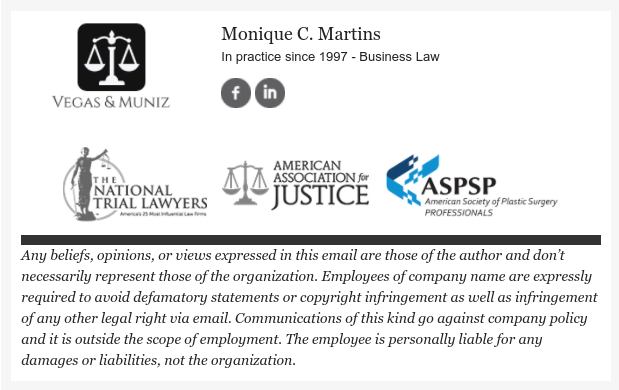This post is also available in: Português
There’s a lot that can go into creating an external and internal email signature. That’s why it’s important to understand that these are two completely unique forms of communication, as the types of email signatures that work best for them are also different.
While there’s plenty of information and different elements that you can include in email signatures, you need to make sure that you don’t include too much information. This is unnecessary and can negatively impact your communications.
To help you create more effective and impactful signatures, this guide explores the key differences between internal and external communications. We’ll also cover exactly what you should include in each email signature.
Table of contents
Internal and external email communication
Internal email communication is often the main way that employees within an organization exchange information.
It’s confined to individuals who share a common work environment, such as colleagues, teams, and various departments. The content of internal emails typically revolves around company-specific matters, internal projects, and announcements relevant to employees.
These communications frequently use a more informal tone, and they have no need to focus on branding, marketing, or promoting the company in any way.
Minimalist email signature examples for internal use.


Internal emails play a crucial role in facilitating collaboration, coordination, and the flow of information within the organization. You need this for teams to function efficiently and for the workforce to be managed cohesively.
On the other hand, external email communication involves interactions with clients, customers, suppliers, and other external stakeholders.
The audience for external emails is diverse, and the content of these emails is geared toward business transactions, customer interactions, marketing efforts, and sales activities.
External communication demands a more formal and professional tone to uphold the company’s image. This requires clarity and a clear strategy for being able to convey your brand and professional image consistently in external messages.
Now, two examples of a more complete HTML email signature for external use.


There’s a lot more at stake with external email communication. That’s why elements like an external email signature play such an important role.
Why do you need email signatures for both?
Email signatures are important elements in both internal and external emails for a couple of different reasons.
For internal communication
An internal email signature helps to create a cohesive and professional image within the organization.
In large teams where face-to-face interactions may be limited, using an internal email signature plays a crucial role in identifying team members and their roles.
A well-crafted internal email signature can include minimalistic yet essential information, like the employee’s name, position, and department. This is necessary for efficient team collaboration.
A professional email signature like this becomes particularly essential in large companies, where individuals may not have regular interaction. It helps to establish a sense of familiarity and coherence within the organization.
Here is another example of a basic email signature for internal use.

Internal email signatures can be valuable tools for reinforcing team identity and sharing essential information among colleagues.
For external communication
In external communication, email signatures play an essential role in enhancing your brand identity and professionalism.
An external signature provides recipients with the information they need to know about the sender. For example, their name, job title, company, and contact details. This reinforces the legitimacy of the communication and makes the sender look more professional.
A well-designed signature contributes to brand consistency and creates a positive impression on clients, customers, and any external partners.
It also serves as a convenient way for external parties to access important contact information. As a result, it contributes to smoother and more effective business interactions.
Again, look at this new email signature example for external use, often seen in emails your customers will open.

Although company email signatures may seem like a small detail, they can make a major difference to communications with anyone outside the organization.
Best practices for internal email signatures
Creating an internal signature may seem like a straightforward task. However, you must include the right information without making the signature too complicated.
To help you create an intra-organizational email signature, here are a few tips and best practices to keep in mind:
Keep it minimalistic
Design a clean and simple signature with essential details like your name, position, and department to maintain a professional yet uncluttered look.
Remember that internal messages don’t need to impress recipients with your brand. They just need to be efficient and easy to understand. Using minimalist email signature templates will help with this.
Use a profile picture
Create a greater personal connection by adding a professional profile picture. This is particularly helpful in large organizations where face-to-face interactions may be limited.
A profile picture makes internal signatures more personal and helps to make communications feel more human.
Highlight the department or team
Include your department or team name to make it easier for recipients to identify you or understand what you do. This is especially important in large organizations with multiple teams.
Maintain consistency
Ensure a unified and professional appearance across all internal email signatures by sticking to consistent formatting and style.
Using the right email signature management software will make this easy for large companies to apply.
Avoid external links
As internal communication usually doesn’t require external references, avoid including unnecessary external links or social media icons. Remember, you’re not trying to promote anything. You just want to make communication between company employees easier.
Video: Creating a minimalist email signature for internal use.
The whole point of an intra-organizational email signature is to add clarity to emails and make communications run a lot smoother. So, keep it simple and only include the necessary information.
Best practices for external email signatures
Different signatures serve different purposes. And external emails need to have particularly well-planned email signatures. As these signatures play such a big role in representing your brand, including the right elements and information in them is essential.
Here are some key details to include in your external signature design:
Include your company logo
Boost brand recognition and professionalism by adding the company logo to your email signature. This is essential, as your external signatures are all about portraying your brand.
Email signature example with logo for external use.

Add contact information
Provide comprehensive contact details, including:
- Relevant phone numbers
- Physical company or office address
- A professional email address
Also read: Best practices for a business email signature.
Enhance online visibility and engagement by incorporating relevant social media icons linked to official company profiles. This is a great way to get your email signature to do some marketing work for your organization. It also makes it easier for external recipients to learn and discover more about your organization.
Insert your website URL
Direct recipients to additional information and resources by including the company website URL in the email signature. This makes your email signature more engaging and helps to send people to your most important online asset – your website.
Standardize fonts and colors
Maintain a polished brand appearance by sticking to a consistent font and color scheme aligned with your company’s brand guidelines.
Use legal disclaimers (if applicable)
You might need to include legal disclaimers in external email signatures. This is only necessary if required by your organization or industry regulations.
Email signature example with legal disclaimer footer.

Optimize for mobile
Ensure mobile-friendliness by keeping the design responsive and avoiding excessive elements that may not display well on smaller screens. This is key as many recipients access emails on mobile devices.
Video: Creating an attractive sales HTML email signature.
The best approach is to use a tool designed to manage email signatures across a company. This should let you access various email signature templates that already include the necessary information and elements for these signatures.
Final thoughts
Creating a professional email signature should be a carefully planned process. There are many different elements that your signatures can include, and making sure that you have the right branding and elements for the right types of emails is essential.

Create your first email signature with Bybrand
Bybrand offers the ability to generate, administer, and distribute essential email signatures for your employees.